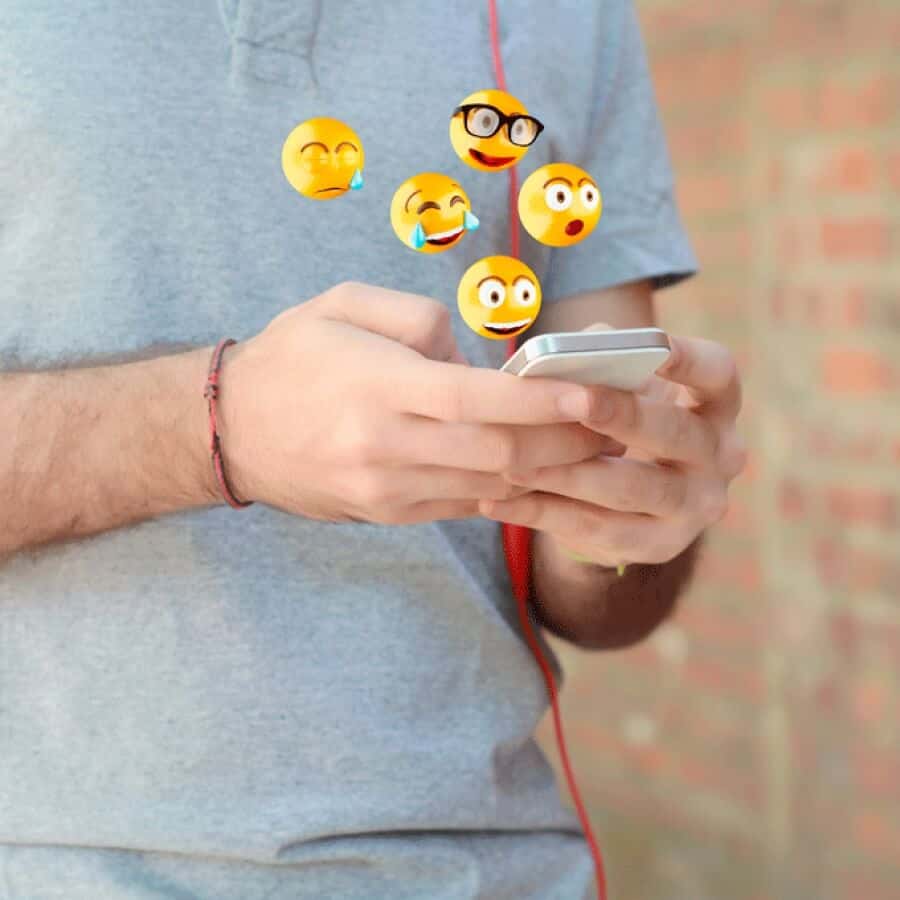Think about it, using emojis or emoticons in everyday written conversation has become a habit of ours, hasn’t it? If you just check your phone you will find that most if not all of your messages are full of emojis! Some messages even consist entirely of emojis! Emoticons are becoming so influential in everyday conversation that they have become a serious topic among linguists. It seems as if we’re traveling back in history, or maybe making a full circle from pictograms to hieroglyphs to phonemic lettering and now slowly but surely back to pictograms.
Are emojis taking over our lives?
What are emoticons if not pictograms: illustrated representations of words, sometimes rich in meaning? In this case emoticons are supposed to represent only, well naturally, emotions. However, that has also changed in the past few years. Now we have whole sets of emoticons – those representing emotions, representing events (engagement, birthday, wedding), animals and plants as well as weather, activities (cycling, skiing, running, playing all kinds of sports). Our conversations will soon be able to consist solely of emojis. Are emojis taking over our lives, or is our way of expressing ourselves changing language itself? And will the spoken language be damaged in some way because of too frequent use of emojis?

Clearly, emojis are only being used in written language. But, when used to “communicate in pictures” we might find that we’re lacking words for everyday conversation, or finding formal conversation tiring.
Word of the Year 2015 was an EMOJI
Vyvyan Evans, linguistics professor at Bangor University, states in his article Signs of our times: why emoji can be even more powerful than words ……… that the Oxford Dictionary found that the Word of the Year 2015 was an EMOJI. Not a word, but an emoji. Word of the Year is the most used word in the specified 1-year period, which is found by precise analysis. So, it comes as no surprise that it was an emoji, does it? So which one was it? The emoji with tears of joy. In his earlier article, Vyvyan reported a finding based on a study that more than 80% of ALL adult smartphone users in the UK regularly use emojis. So, don’t blame it on the young. To add, the professor also states that no matter which “type” of language we use – spoken or sign language – language in any form serves its purpose: it conveys a message. And conveying the message is the primary purpose of any language. To conclude, Vyvyan states that we are living in the age of emojis.
Most used emojis in different countries
If you’re wondering which emojis are most used in different places on Earth, SwiftKey.Blog has made a list. Here is what they discovered:

- Canadians score highest for the poop emoji compared to other countries
- Canadians also score highest in emoji categories you might typically think of as ‘all-American’ (money, raunchy, violent, sports)
- The French use four times as many heart emojithan other languages, and it’s the only language for which the ‘smiley’ emoji is not #1
- Arabic speakers use flowers and plantsemoji 4 times more than average
- Russian speakers are the biggest romantics, using three times as many romance-themed emoji than the average
- Australia is the land of vices and indulgenceaccording to the emoji data, using double the average amount of alcohol-themed emoji, 65% more drug emoji than average and leading in both junk food and holiday emoji
- Judging by their use of emoji, Americans are the most LGBT, using these emojis more than others
- Americans also lead for a random assortment of emoji & categories, including skulls, birthday cake, fire, tech, meat, and female-oriented emoji
But, what do psychologists say about the use of emojis?
Emojis have a great potential in their usage. The unique thing about the emojis is that the understanding of the emoji’s meaning lies in the mind of the receiver. Emojis by themselves can mean a lot of things, and through internet culture they acquire even more meanings and can be interpreted in various ways.
There is one interesting thing about emojis that Monica A Riordan, Ph.D., has stated in Psychology Today: “We use text messaging to communicate with many different types of people: our spouses or partners, co-workers, and friends. We play a different social role in each relationship. Each social role requires that you act differently, and we perform these actions to preserve the relationship. These actions are called ‘emotion work.’ The unique flexibility of emojis makes them perfectly suited to be tools for this emotion work. Not only are they able to convey a great deal, but the meaning is whatever the receiver wants it to be. Thus, rather than taking the risk of saying the wrong thing, my husband simply texts a heart emoji instead. Because I want my husband to be supportive of me, I choose to interpret the heart emoji in a positive way. Thus the communication is successful; our relationship is preserved. It does not really matter whether I correctly interpreted exactly what he meant when he sent the emoji.”
New ways to preserve relationships between people
Isn’t it kind of weird that emojis at the same time play such an important role like preserving a relationship between people, but also possibly being misinterpreted? That only means that the REAL meaning of the emoji does not exist, it always varies, it depends on the person, it is different from person to person, message to message. Also, Monica A Riordan argues that emojis are a great way to express positive feelings and, also, to soften the negative ones. It’s needless to say that emojis have great potential by being loaded with meaning; but also, they are great for enriching our communication with people, especially those close to us, and for expressing our positive emotions, particularly when we can’t do it in person.
Good or bad, emojis are certainly an important part of everyday written conversation, and that won’t change any time soon. Is it possible that emojis will take over all written conversation, and infiltrate themselves into every aspect of communication? Think about it. Anyway, the influence of emojis can’t be denied. Because of the flexibility of emojis’ meanings, the interpretation of messages rich in emojis or consisting just of emojis depends on many factors, for example: who the sender is, what relationship the sender has with the receiver, and what is the context in which the message was sent.
As Vyvyan said, one thing is certain: emojis are literally a SIGN of our times.
Photos: Shutterstock
Support us!
All your donations will be used to pay the magazine’s journalists and to support the ongoing costs of maintaining the site.
Share this post
Interested in co-operating with us?
We are open to co-operation from writers and businesses alike. You can reach us on our email at [email protected]/[email protected] and we will get back to you as quick as we can.









